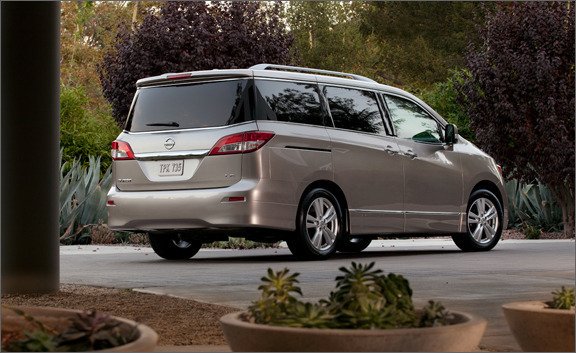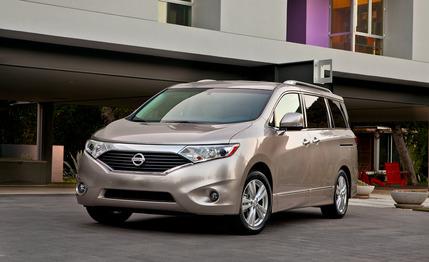
 First Drive Review
First Drive Review
Minivan sales collapsed from more than 1.1 million in 2004 to a little over 400,000 in 2009. The number of players in the game has dropped as well, with Ford and GM backing out years ago and Hyundai following suit for 2010—yeah, we didn’t notice, either. But the near-dormant segment is receiving a solid shake-up for 2011, with five of America’s remaining breadboxes being massively upgraded or completely redesigned. Of all of them, none went through a more thorough metamorphosis than the Nissan Quest.
Although Honda and Toyota took some risks in the styling of the new Odyssey and Sienna, respectively, Quest designers chucked the outgoing model’s geomechanical forms for something totally unexpected. Among the notable design bits is a swooping trapezoidal grille and headlamp treatment, which leads into a severely raked hood and windshield. Blacked-out B-, C-, and D-pillars give the van a floating-roof look like that embraced by Range Rover fans, and the arrow-straight waistline, the deep, slablike skirts, and the bolt-upright liftgate visually heighten it. Although the Quest looks nothing like the previous model in any respect, it is just as polarizing. We’ll go on record as stating that we like it—for the most part—when cars cause controversy with their styling, especially when they are minivans.
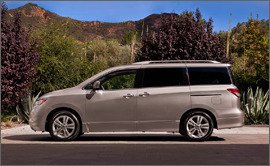

The Infiniti of Minivans
Less controversial is the 2011 Quest’s interior. The dashboard and the deep gauge pod appear far more upscale than those of the Odyssey or Sienna and wouldn’t look out of place in an Infiniti. As with the refreshed 2011 Dodge Grand Caravan and Chrysler Town & Country, cheap plastic touch points have largely been banished. The most notable replacements are on the dash and door uppers, the former rendered in glare-mitigating matte black and the latter in stitched-and-padded leather.
The first- and second-row captain’s chairs (there is no second-row-bench option) are superbly comfortable, and even the third row isn’t a penalty box, thanks to theater-style seating and the absence of a second-row center seatback. The Quest’s narrower width makes row three a tight squeeze for a trio of adults, but the same space in the Sienna or Odyssey hardly feels like business class, either. We’d issue a demerit for the headliner, too, which looks and feels rather low-rent compared with the rest of the interior.
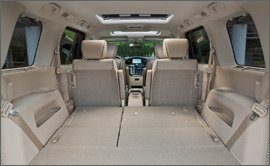

The greatest demerit is reserved for cargo capacity, though, which is way down versus the cavernous competition. Because none of the Quest’s seats folds into the floor, as they variously do in its competitors, the Nissan has nearly 40 percent less available cargo space than the Odyssey. Although the seats don’t hide in the floor, they can be folded flat quickly and easily and doing so doesn’t require the relocation of any cargo stowed in the deep covered storage well behind the rear bench.
Unlike its most ambitious competitors, Nissan chose not to offer multiple entertainment screens in the rear cabin, offering instead a single 11-inch screen that drops down from the ceiling in front of row two. If one of the kiddies doesn’t feel like watching what’s on the big screen, he or she can stare through the optional dual sunroofs on Quests so equipped, both of which slide open for a unique two-row alfresco ceiling treatment.
Van and Driver
On the road, the Quest’s driver might actually enjoy the drive. Well, at least he or she probably won’t hate it or feel as if he or she were piloting something as ponderous or clumsy as a typical minivan. The Quest’s rock-solid new structure yields a wonderfully boom-free cabin as well as reasonably tidy handling, and the electrohydraulic speed-sensitive steering has positive on-center feel with a natural buildup in effort as one turns the wheel. Smooth transitions are easy in the Quest, and that’s not something we can say about every family box out there.
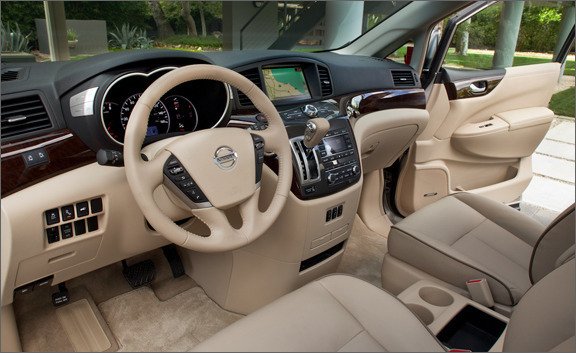

Rated at 260 hp and 240 lb-ft of torque, the Quest’s 3.5-liter V-6 is largely carry-over. Although it doesn’t give the 4400-plus-pound van a cheetah-like pounce, it does have sufficient grunt to generate mild torque steer. The bigger letdown is bolted to the engine, where the only transmission choice is a CVT. We never enjoy the characteristic engine moan that accompanies these transmissions, but we don’t suppose many Quest buyers will notice.
Features and Options
When it arrives early next year, the Quest will start at $28,550. The base S model will be equipped with 16-inch steel wheels, a six-CD stereo, keyless entry, pushbutton start, a removable center console between the second-row seats, and “wood tone” trim, but few other frills. At $31,800, the SV adds 16-inch aluminum wheels, power-sliding doors, fog lights, a 4.3-inch color display in the center of the dash, three-zone automatic climate control, Bluetooth connectivity, a USB port, and a leather-wrapped steering wheel with audio controls, among other things. At $35,150, the SL brings leather upholstery, 18-inch wheels, a power liftgate, roof rails, a power driver’s seat, heated front seats, heated exterior mirrors, and a quick-release function for the fold-flat third-row seats. Finally, the range-topping LE adds Nissan’s wonderfully intuitive navigation system with an eight-inch display, a 9.3-gig infotainment system with 13 Bose speakers, rear-seat DVD entertainment, blinds for the rear side windows, Nissan’s new air-scrubbing advanced climate-control system, blind-spot warning, xenon headlamps, and more, for $42,150.
The only major option LE buyers can add is the dual sunroofs. SL buyers can choose the sunroofs, the DVD system, and the Bose package. Sadly missing from the options list are the second-row captain seats from the Quest’s Japanese-market twin, the Elgrand, which feature articulating seatbacks and chaise-style calf rests—so much for snatching sales from Maybach.
As for snatching sales from the equally shiny and new leaders in the minivan class, the Quest has never stood a better chance. Of all the 2011 minivan offerings, it is arguably the coolest—or at least the most bold—and coolness is a quality not often found in this segment.
